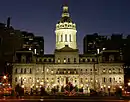Morgan State University
Morgan State University (Morgan State or MSU) is a public historically black research university in Baltimore, Maryland. It is the largest of Maryland's historically black colleges and universities (HBCUs). In 1890, the university, then known as the Centenary Biblical Institute, changed its name to Morgan College to honor Reverend Lyttleton Morgan, the first chairman of its board of trustees and a land donor to the college.[8] It became a university in 1975.
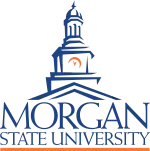 | |
Former names | Centenary Biblical Institute (1867–1890) Morgan College (1890–1939) Morgan State College (1939–1975) Morgan State University (1975-present) |
|---|---|
| Motto | Growing the Future and Leading the World |
| Type | Public historically black research university |
| Established | 1867 |
Academic affiliations | |
| Endowment | $41.4 million (2020)[1][2][3] |
| President | David Wilson |
| Provost | Hongtao Yu |
Academic staff | 1,556 |
Administrative staff | 437 |
| Students | 9,101[4] |
| Undergraduates | 7,609[4][5] |
| Postgraduates | 1,492[5] |
| Location | , , United States 39.344°N 76.585°W |
| Campus | Urban, 143 acres (0.58 km2) |
| Newspaper | The Spokesman[6] |
| Colors | Blue and Orange[7] |
| Nickname | Bears |
Sporting affiliations | National Collegiate Athletic Association NCAA Division I – Mid-Eastern Athletic Conference (MEAC) |
| Website | www |
Morgan State is a member of Thurgood Marshall College Fund. Although a public institution, Morgan State is not part of the University System of Maryland. It is classified among "R2: Doctoral Universities – High research activity".[9]
History
| Centenary Biblical Institute | |
|---|---|
| 1869–1882 | J. Emory Round |
| 1882–1888 | W. Maslin Frysinger |
| Morgan College | |
| 1888–1901 | John J. Wagner |
| 1901–1902 | Charles Edmond Young (acting) |
| 1902–1937 | John O. Spencer |
| Morgan State College | |
| 1937–1948 | Dwight O.W. Holmes |
| 1948–1970 | Martin D. Jenkins |
| 1970–1971 | Thomas P. Fraser, II (interim) |
| 1971–1974 | King Virgil Cheek |
| 1974–1975 | Thomas P. Fraser |
| Morgan State University | |
| 1975–1984 | Andrew Billingsley |
| 1984–2010 | Earl S. Richardson |
| 2010–present | David Wilson |
Morgan State University (MSU) is a historically black college in Baltimore, Maryland. It was founded in 1867 as the Centenary Biblical Institute, a Methodist Episcopal seminary, to train young men in the ministry. At the time of his death, Thomas Kelso, co-founder and president of the board of directors, endowed the Male Free School and Colored Institute through a legacy of his estate.[10][11][12]
It later broadened its mission to educate both men and women as teachers. The school was renamed as Morgan College in 1890 in honor of the Reverend Lyttleton Morgan, the first chairman of its board of trustees, who donated land to the college.[8] In 1895, the institution awarded its first baccalaureate degree to George W. F. McMechen, after whom the building of the school of business and management is named today. McMechen later earned a law degree from Yale University and, after establishing his career, became one of Morgan's main financial supporters.[13]
In 1915, Andrew Carnegie gave the school a grant of $50,000 for a central academic building. The terms of the grant included the purchase of a new site for the College, payment of all outstanding obligations, and the construction of a building to be named after him. The College met the conditions and moved to its present site in northeast Baltimore in 1917.
In 1918, the white community of Lauraville tried to have the sale revoked by filing suit in the circuit court in Towson, upset that the Ivy Mill property, the planned location of Morgan State, had been sold to a "negro" college. The circuit court dismissed the suit, which the community appealed to the Maryland Court of Appeals.[14] The appellate court upheld the lower court decision, finding no basis that siting the college at this location would constitute a public nuisance.[15] Despite some ugly threats and several demonstrations against the project, Morgan College was constructed at the new site and later expanded. Carnegie Hall, the oldest original building on the present Morgan campus, was erected a year later.
Morgan remained a private institution until 1939. That year, the state of Maryland purchased the school. Morgan College became Morgan State College. In 1975, Morgan State added several doctoral programs and its board of directors petitioned the Maryland Legislature to be granted university status.
The university made national news in 2013 when it was reported that student Alexander Kinyua, 21 at the time, had killed his roommate and then eaten the victim's heart and brain. Kinyua, who had previously been dismissed from Morgan State's ROTC program, confessed to the crime.[16]
In 2020, MacKenzie Scott donated $40 million to Morgan State. The donation is the largest in Morgan State's history and one of the largest ever to a HBCU.[17] The following year, Calvin E. Tyler Jr. donated $20 million to endow scholarships for financially needy students at Morgan State. Tyler donation's is believed to be the largest single donation a former student made to his or her historically black institution.[18]
21st century construction
.jpg.webp)
In the 21st century, the university has seen the construction of a new student union, two dedicated parking garages, the Earl S. Richardson Library, the Dixon Research Center, the Communications Building, and the Center for the Built Environment and Infrastructure Studies. The latter two buildings, plus one of the two parking garages, are in the far north of the campus, connected by a new Communications Bridge over Herring Run. The central quad was also rebuilt, completed in early 2012, and includes a direct connection between the two main bridges on campus and many new bicycle racks.
The Carl J. Murphy Fine Arts Center has become an important venue for plays and concerts visiting Baltimore, and is also the home of the James E. Lewis Museum of Art, a museum of African-American art. In September 2012, Morgan State opened the Center for the Built Environment and Infrastructure Studies (CBEIS) which houses the School of Architecture and Planning, School of Transportation Studies, and the School of Engineering.
The university's Earl G. Graves School of Business and Management opened in 2015.
Academics
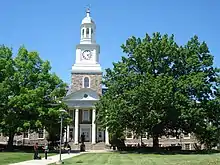
Morgan State awards baccalaureate, master's, and doctorate degrees. More than 9,000[4] students are enrolled at Morgan. At the graduate level, the university offers the Master of Arts, Master of Business Administration, Master of Science, Master of Education, Doctor of Education, Doctor of Philosophy, Doctor of Engineering, and Doctor of Public Health.
Enrollment
As of the fall of 2022, there were 7,609 undergraduates and 1,392 graduate students enrolled at Morgan,[4][5] and 44% were non-Maryland residents,[4] including many from foreign countries, like Saudi Arabia, Kuwait, and Nigeria. The largest sources of enrollment outside of Maryland are New York, New Jersey, and Pennsylvania.[19]
From 2006 to 2019 the number of African-American students remained constant, but the numbers of other racial groups, including Hispanic/Latino and non-Hispanic white students increased. International students also increased in that period. In 2006 the student count was 6,700, including 60 Hispanic/Latino students, and in 2019 it was up to 7,700, including 260 Hispanic/Latino students.[20]
Schools and colleges
The university operates twelve colleges, schools, and institutes.
- College of Interdisciplinary and Continuing Studies
- College of Liberal Arts
- School of Business and Management
- School of Education and Urban Studies
- School of Engineering
- School of Computer, Mathematical, and Natural Sciences
- School of Graduate Studies
- School of Architecture and Planning
- School of Community Health and Policy
- Patuxent Environmental & Aquatic Research Laboratory
- School of Social Work
- School of Global Journalism and Communication
- Dr. Clara Adams Honors College
College of Liberal Arts
The College of Liberal Arts is the largest academic division at the university. In addition to offering a wide variety of degree programs, it also offers a large portion of the courses in the university's general education requirements. The College of Liberal Arts offers three doctoral programs (PhD), six Master of Arts (MA), two Master of Science (MS), eleven Bachelor of Arts (BA), two Bachelor of Science (BS), one Bachelor of Fine Arts (BFA), and twenty-three minors, all in topics such as Economics, English, History, African American Studies, African Diaspora Studies, East Asian Studies, Environmental Studies, Latino Studies, Military Science, Philosophy, Screenwriting, Sociology, and World Languages, among others.[21]
The College of Liberal Arts hosts also two museums: James E. Lewis Museum of Art and Lillie Carroll Jackson Civil Rights Museum. The James E. Lewis Museum of Art (JELMA) is the cultural extension of Morgan State University's Fine Arts academic program. The Lillie Carroll Jackson Civil Rights Museum illustrates the last recorded lynching in Maryland.
School of Business and Management
The Earl G. Graves School of Business and Management (GSBM) is named in honor of alumnus Earl G. Graves, Sr. and is housed in the Graves School of Business and Management building, which was opened for the Fall Semester 2015 at the western edge of the campus. It is a state-of-the-art classroom, laboratory, office building, with rooms for hospitality management students to operate. The GSBM offers Bachelor of Science degrees, a Master of Business Administration, a Master of Science, and a PhD degree. These programs are accredited by The Association to Advance Collegiate Schools of Business (AACSB).
School of Education and Urban Studies
The School of Education and Urban Studies is located in Banneker Hall. The school offers undergraduate and Masters-level degree programs.
School of Engineering
.jpg.webp)
The School of Engineering admitted its first class starting in 1984. The first graduates received degrees in 1988. Eugene M. DeLoatch (retired 2016) was the first Dean of the School of Engineering, having previously been Chairman of the Department of Electrical Engineering at Howard University. He was succeeded by Dr. Michael G. Spencer who was previously a professor of electrical engineering at Cornell University.
The Morgan State University, School of Engineering has ABET-accredited undergraduate programs. The school's graduate programs confer the Master of Engineering Degree, Doctor of Engineering Degree, and Master of Transportation Degree.
By 1991, the construction of the 35,000 sq ft (3,300 m2) Clarence M. Mitchell, Jr. School of Engineering building was completed, and the facility included sixteen teaching laboratories and five research laboratories. The William Donald Schaefer Building is a 40,000 sq ft (3,700 m2) addition to the Engineering School and was completed in April 1998. The facility provided instructional laboratories, classrooms, a student lounge, research laboratories and a 2,200 sq ft (200 m2) library annex. In 2015 Morgan State University's School of Engineering graduates provided more than two-thirds of the state's African-American Civil Engineers, 60 percent of the African-American Electrical Engineers, 80 percent of the African-American Telecommunications specialists, more than one-third of the African-American Mathematicians, and all of Maryland's Industrial Engineers.[22]
School of Architecture and Planning (S+AP)
In 1997, it is the only HBCU to establish accredited Architecture, Landscape Architecture, and City and Regional Planning programs. A plan was announced by Earl Richardson in 2005 for the program to establish school status and it was designated as the School of Architecture and Planning (S+AP) in 2008.[23] The Center of Built and Environmental Studies (CBEIS) was designed by Hord Coplan and Macht in association with the Freelon Group. They began construction in 2010 to house all of the related majors and the building has been declared one of the most impressive, environmentally friendly university buildings in the world. The School of Architecture and Planning granted its first Interior Design baccalaureates in 2020.[24]
Library
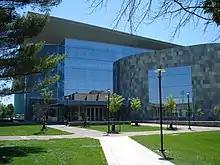
The Earl S. Richardson Library's is the main academic information resource center on the campus. The new building covers approximately 222,517 square feet which opened in 2008. The library's holding constitutes over 500,000 volumes, and access to over 1 million e-books and 5,000 periodical titles. There are 167 online databases that are subscribed to the Library. Reading and studying spaces are provided with wired and wireless access to databases for research.[25] One such collection in the volumes includes books on Africa, with an emphasis on sub-Saharan Africa. The African-American collection includes papers and memorabilia of such persons as Emmett Jay Scott, secretary to Booker T. Washington. The Forbush Collection is composed of materials associated with the Quakers and slavery. The Martin D. Jenkins Collection was acquired in 1980.[25]
Student life and activities
Athletics
Morgan's athletic teams are known as the Bears, and they compete in the Mid-Eastern Athletic Conference (MEAC). Between 1926 and 1928, a young Charles Drew served as Athletic Director. During this time he made great improvements in the school's teams' records.[26] From the 1930s through 1960s, led by coach and then athletic director Edward P. Hurt, Morgan's athletic teams were legendary. More than thirty of its football players were drafted by and played in the NFL[27] and many of its track athletes competed internationally and received world-class status. By the late 1960s most white colleges and universities ended their segregation against black high school students[28] and many top black high school students and athletes started matriculating to schools from which they had been barred just a decade prior. While achieving a national goal of desegregation, integration depleted the athletic strength of schools like Morgan State and Grambling State University. For example, the annual contest between Morgan State and Grambling played in New York City in the late 1960s drew more than 60,000 fans.[29] Morgan State archrivals are the Howard University Bison (the matchup is often called the Battle of the Beltway) and the Coppin State Eagles.
In 2021, Morgan State announced plans to revive their wrestling program that was discontinuted in 1997 thanks to a $2.7 million donation from a group dedicated to bringing back wrestling to HBCUs. The donation, the largest in Bears history, would make Morgan State the only Division I HBCU to offer wrestling.[30]

Lacrosse
By 1975 Morgan State became noted for its lacrosse team. Morgan State was the first—and, until the turn of the 21st century, the only—historically black university to field a lacrosse team.[14]
In 2005 students organized a lacrosse club which plays other college's lacrosse clubs, but the team has yet to qualify to become an NCAA-sanctioned team.[31]
Basketball
In 2009, the Morgan State men's basketball team won the MEAC regular season and tournament championship and qualified for the 2009 NCAA Division I men's basketball tournament. In their first tournament appearance, the 15th-seeded Bears lost to the 2008–09 Oklahoma Sooners men's basketball team Oklahoma Sooners, 82–54, in the first round of the South Regional.[32]
In 2010 the Morgan State men's basketball team again won the MEAC regular season and tournament championship[33] and qualified for the 2010 NCAA Division I men's basketball tournament, again as a 15 seed. Morgan State lost to West Virginia University in the first round by a score of 77–50.[34]
Athletic Hall of Fame
More than two hundred men and women Morgan State athletes have been inducted into the Morgan State University Hall of Fame including National Football League Hall of Famers Rosey Brown, Leroy Kelly and Willie Lanier, two-time Olympic Gold medalist George Rhoden, and the coach of the Ten Bears lacrosse team Howard "Chip" Silverman.
Choir
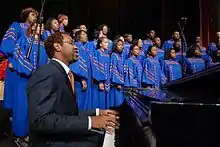
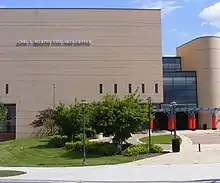
The Morgan State University Choir is one of the nation's most prestigious university choral ensembles and was led for more than three decades by the late Dr. Nathan Carter, celebrated conductor, composer, and arranger. The groups that are subdivisions of the critically acclaimed choir include the University Choir, which is over 140 voices strong, and The Morgan Singers (approximately 40 voices). The Morgan State University Choir has performed for audiences throughout the United States and all over the world—including The Bahamas, Virgin Islands, Canary Islands, Canada, Africa, Asia, and Europe. [35]
Band

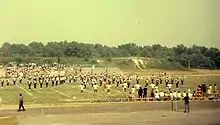
The Morgan State University Band Program consists of six ensembles: the marching band, symphonic band, symphonic winds, pep band, jazz ensemble, and jazz combo. Self-titled the Magnificent Marching Machine, the marching band has performed at Morgan State football games, NFL games, Presidential Inaugurations, World Series games and in regional and local television appearances.[36] The band also made a cameo appearance in the 2003 American movie Head of State and appeared on The Skyshow, a television show featuring Tom Joyner.
On November 28, 2019, the Magnificent Marching Machine, made its first-ever appearance the Macy's Thanksgiving Day Parade.[37]
Greek life
Morgan State University has many fraternity and sorority chapters.
Notable alumni and faculty
Alumni
Alumni of Morgan State University have achieved notability in the fields of athletics, science, government, law, the arts, and the military including four members of the NFL Football Hall of Fame (Willie Lanier, Roosevelt Brown, Leroy Kelly, and Len Ford), Black Enterprise Magazine publisher Earl Graves, the Chief Judge of Maryland's highest court, Clarence Dunnaville, lawyer and civil rights activist, and nearly a dozen U.S. Army Generals including Lieutenant General William "Kip" Ward, the first Commanding Officer of the United States Africa Command. The New York Times sports columnist William C. Rhoden, playwright, TV producer, and entrepreneur David E. Talbert, and American-Israeli Olympic sprinter Donald Sanford are also alumni. Civil rights activist and music critic for the Baltimore Afro-American newspaper Adah Jenkins graduated from Morgan State as did scientist and inventor Valerie Thomas.
Faculty
Former faculty member Ernest Lyon was a United States Ambassador to Liberia and the founder of the Maryland Industrial and Agricultural Institute for Colored Youths.[38] Noted African American historian and pioneering scholar Dr. Benjamin A. Quarles served on its faculty for many decades. Physician-Scientist Charles R. Drew,[39] known for his work on blood transfusion, was Morgan College's First Athletic Director. Flora E. Strout, Morgan College teacher and principal, wrote the school's anthem. Notable faculty currently teaching at Morgan State University include bestselling author and filmmaker MK Asante, and scholar Raymond Winbush, and African-American historian Rosalyn Terborg-Penn.
Notes
- A^ Iota Phi Theta was founded at Morgan State University on September 19, 1963.
References
- "2020 Morgan State University Foundation Inc. Report" (PDF). MSU Foundation Inc. Retrieved September 29, 2021.
- "Morgan State University – Education Rankings & Advice". US News. Retrieved January 28, 2021.
- "Best Colleges: Morgan State University". U.S. News & World Report. Retrieved January 28, 2021.
- "Morgan At A Glance". About Morgan State. Morgan State University. Retrieved October 4, 2023.
- "Wilson's contract extended to 2030 to remain at Morgan". The Daily Record. BridgeTower Media. May 2, 2023. Retrieved October 4, 2023.
- "Home". themsuspokesman.com.
- "Morgan State University: Branding Toolkit". Morgan State University. Archived from the original on November 9, 2017. Retrieved March 31, 2017.
- Stone, Adam (August 19, 2002). "Morgan State University This historically black college has a well-rounded liberal arts core". Baltimore Sun. Archived from the original on September 27, 2007. Retrieved March 20, 2009.
- "Carnegie Classifications Institution Lookup". carnegieclassifications.iu.edu. Center for Postsecondary Education. Retrieved September 12, 2020.
- Morgan State University Spokesman 'Our Forefathers: The Founders of Morgan State', Feb, 8, 2002, Cox Archived March 21, 2011, at the Wayback Machine
- History of Baltimore City and County, from the earliest period to the present day: including biographical sketches of their representative men, John Thomas Scharf, p. 667
- "Got My Mind Set on Freedom": Maryland's Story of Black and White Activism, 1663–2000, Barbara Mills, Heritage Books 2002, p. 345
- "Brief History of Morgan State University". Morgan State University. Archived from the original on December 28, 2013. Retrieved March 10, 2013.
- Harrison, Miles Jr.; Chip Silverman (2001). Ten Bears. USA: Positive Publications. p. 19. ISBN 0-9679922-1-4.
- Diggs v. Morgan College, 105 A. 157 270, 133 (Md. 264 October 30, 1918) ("Decree affirmed").
- Griego, Monique (February 28, 2013). "Morgan State University Sued Over Attack By Confessed Cannibal". CBS News. Retrieved August 18, 2023.
- "Billionaire MacKenzie Scott donates record-breaking $40 million to Morgan State University". December 15, 2020.
- Saul, Stephanie (February 23, 2021). "He Had to Drop Out of College. Then He Gave It $20 Million". The New York Times.
- "Morgan State University Fall 2019 Student Demographics" (PDF). Morgan.edu. Retrieved September 13, 2020.
- Richman, Talia (October 9, 2019). "A historically black college in Maryland is growing — by enrolling Hispanic, white and international students". The Washington Post. Retrieved August 31, 2021.
- "Departments. College of Liberal Arts". Retrieved September 13, 2020.
- "Clarence M. Mitchell, Jr. – School of Engineering". Morgan State University – School of Engineering. Archived from the original on April 27, 2015. Retrieved April 27, 2015.
- "Our History". Morgan State University. Retrieved July 30, 2020.
- Johnson, Justin (October 19, 2018). "Morgan launches first interior design baccalaureate program in Maryland". The Spokesman. Retrieved July 30, 2020.
- "Earl S. Richardson Library". Morgan State University.
- "The Charles R. Drew Papers". nih.gov. March 12, 2019.
- "NFL Players who attended Morgan State University". databasefootball.com.
- "Professor Revising History of College Desegregation". Archived from the original on June 19, 2007.
- Janofsky, Michael; Rogers, Thomas (January 28, 1984). "Sports: Scouting". The New York Times. Retrieved January 8, 2009.
- Large Gift Revives Wrestling at Morgan State; HBCU Wrestling Initiative Enacted
- Daraji, Malachi (July 1, 2005). "Lacrosse Returns to Morgan State University". The Spokesman. Retrieved March 15, 2008.
- "NCAA Tournament Bracket – 2009". ESPN. Retrieved March 28, 2009.
- "Morgan State Wins 2010 MEAC Men's Tournament". MEACSports.com. March 14, 2010.
- "Morgan State Bears vs. West Virginia Mountaineers – NCAA Tournament Game – Box Score – March 19, 2010 – ESPN". ESPN.
- "About the Choir".
- "Morgan State University Marching Band". Morgan State Athletics. Retrieved April 27, 2015.
- "Morgan's Marching Band Lights Up Macy's Thanksgiving Day Parade". December 2, 2019.
- "Biography" (PDF).
- "Former Morgan Professor Dr. Charles Drew Inducted into National Inventors Hall of Fame". May 11, 2015.
